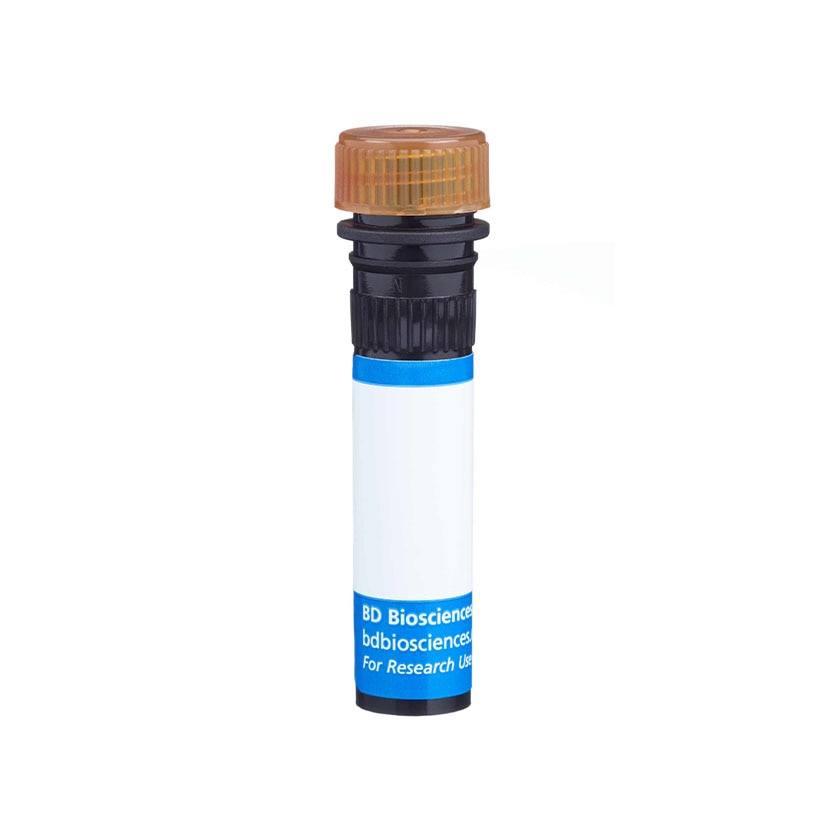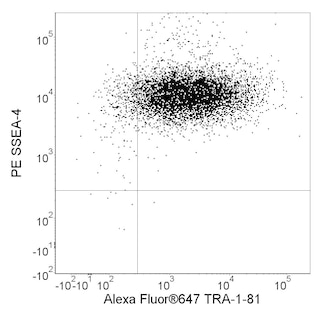Old Browser
This page has been recently translated and is available in French now.
Looks like you're visiting us from {countryName}.
Would you like to stay on the current country site or be switched to your country?




Flow cytometric analysis of SSEA-1 expression on E14 cells. E14 mouse embryonic stem (ES) cells were stained with either PerCP-Cy™5.5 Mouse Anti-SSEA-1 (Cat. No. 561560; solid line histogram) or PerCP-Cy™5.5 Mouse IgM, κ Isotype Control (Cat. No. 560857, dashed line histogram), incubated in the dark for 20 minutes at room temperature and analyzed by flow cytometry. Fluorescence histogram depicting SSEA-1 (or Ig isotype expression) were derived from gated events with the side and forward light-scattering characteristics of viable cells. Flow cytometry was performed on a BD FACSCalibur™ System.


BD Pharmingen™ PerCP-Cy™5.5 Mouse Anti-SSEA-1

Regulatory Status Legend
Any use of products other than the permitted use without the express written authorization of Becton, Dickinson and Company is strictly prohibited.
Preparation And Storage
Recommended Assay Procedures
BD™ CompBeads can be used as surrogates to assess fluorescence spillover (Compensation). When fluorochrome conjugated antibodies are bound to CompBeads, they have spectral properties very similar to cells. However, for some fluorochromes there can be small differences in spectral emissions compared to cells, resulting in spillover values that differ when compared to biological controls. It is strongly recommended that when using a reagent for the first time, users compare the spillover on cell and CompBead to ensure that BD Comp beads are appropriate for your specific cellular application.
Product Notices
- This reagent has been pre-diluted for use at the recommended Volume per Test. We typically use 1 × 10^6 cells in a 100-µl experimental sample (a test).
- An isotype control should be used at the same concentration as the antibody of interest.
- Source of all serum proteins is from USDA inspected abattoirs located in the United States.
- Caution: Sodium azide yields highly toxic hydrazoic acid under acidic conditions. Dilute azide compounds in running water before discarding to avoid accumulation of potentially explosive deposits in plumbing.
- Please observe the following precautions: Absorption of visible light can significantly alter the energy transfer occurring in any tandem fluorochrome conjugate; therefore, we recommend that special precautions be taken (such as wrapping vials, tubes, or racks in aluminum foil) to prevent exposure of conjugated reagents, including cells stained with those reagents, to room illumination.
- PerCP-Cy5.5–labelled antibodies can be used with FITC- and R-PE–labelled reagents in single-laser flow cytometers with no significant spectral overlap of PerCP-Cy5.5, FITC, and R-PE fluorescence.
- PerCP-Cy5.5 is optimized for use with a single argon ion laser emitting 488-nm light. Because of the broad absorption spectrum of the tandem fluorochrome, extra care must be taken when using dual-laser cytometers, which may directly excite both PerCP and Cy5.5™. We recommend the use of cross-beam compensation during data acquisition or software compensation during data analysis.
- For fluorochrome spectra and suitable instrument settings, please refer to our Multicolor Flow Cytometry web page at www.bdbiosciences.com/colors.
- Cy is a trademark of GE Healthcare.
- Please refer to http://regdocs.bd.com to access safety data sheets (SDS).
- Species cross-reactivity detected in product development may not have been confirmed on every format and/or application.
- Please refer to www.bdbiosciences.com/us/s/resources for technical protocols.
Companion Products


The MC480 monoclonal antibody reacts with Stage-Specific Embryonic Antigen-1 (SSEA-1), which is a terminal carbohydrate epitope (3-fucosyl-N-acetyllactosamine or 3-FAL) on glycoproteins and lactose-series glycolipids. SSEA-1 is related to Lewis blood group antigens and is found in a variety of embryonic as well as adult tissues and cancers. As its name implies, the expression of SSEA-1 is stage-specific and can be used to characterize embryonic cells and monitor their differentiation. However, its expression pattern differs between human and mice. In the human, SSEA-1 is not found on embryonic stem (ES) cells, embryonic inner cell mass (ICM), or teratocarcinoma (embryonal carcinoma or EC) cells. As human EC and ES cells undergo differentiation, SSEA-1 expression is upregulated. In the adult, the same epitope is expressed as CD15 on granulocytes and monocytes, but not lymphocytes or dendritic cells. In the mouse, SSEA-1 is found on EC, ES, primordial germ cells, 8-cell to blastocyst embryos, ICM, and subpopulations of cells in the adult central nervous system, including stem cells. In contrast to human SSEA-1 expression, it is reduced when mouse EC and ES cells undergo differentiation.

Development References (7)
-
Capela A, Temple S. LeX/ssea-1 is expressed by adult mouse CNS stem cells, identifying them as nonependymal. Neuron. 2002; 35:865-875. (Biology).
-
Childs RA, Pennington J, Uemura K, et al. High-molecular-weight glycoproteins are the major carriers of the carbohydrate differentiation antigens I, i and SSEA-1 of mouse teratocarcinoma cells. Biochem J. 1983; 215:491-503. (Clone-specific).
-
Draper JS, Pigott C, Thomson JA, Andrews PW. Surface antigens of human embryonic stem cells: changes upon differentiation in culture. J Anat. 2002; 200:249-258. (Clone-specific). View Reference
-
Henderson JK, Draper JS, Baillie HS, et al. Preimplantation human embryos and embryonic stem cells show comparable expression of stage-specific embryonic antigens. Stem Cells. 2002; 20:329-337. (Clone-specific). View Reference
-
Kannagi R, Nudelman E, Levery SB, Hakomori S. A series of human erythrocyte glycosphingolipids reacting to the monoclonal antibody directed to a developmentally regulated antigen, SSEA-1. J Biol Chem. 1982; 257(24):14865-14874. (Clone-specific).
-
Solter D, Knowles BB. Monoclonal antibody defining a stage-specific mouse embryonic antigen (SSEA-1). Proc Natl Acad Sci U S A. 1978; 75(11):5565-5569. (Immunogen). View Reference
-
Thomson JA, Itskovitz-Eldor J, Shapiro SS, et al. Embryonic stem cell lines derived from human blastocysts. Science. 1998; 282:1145-1147. (Clone-specific). View Reference
Please refer to Support Documents for Quality Certificates
Global - Refer to manufacturer's instructions for use and related User Manuals and Technical data sheets before using this products as described
Comparisons, where applicable, are made against older BD Technology, manual methods or are general performance claims. Comparisons are not made against non-BD technologies, unless otherwise noted.
For Research Use Only. Not for use in diagnostic or therapeutic procedures.